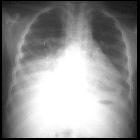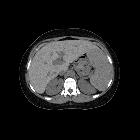splenic siderotic nodules







Splenic siderotic nodules, also known as Gamna-Gandy bodies, of the spleen, are most commonly encountered in portal hypertension. The pathophysiological process is the result of microhemorrhage resulting in hemosiderin and calcium deposition followed by fibroblastic reaction.
Pathology
Grossly, Gamna-Gandy bodies are characterized by many well-circumscribed nodules measuring several millimeters, with a dark hemorrhagic center surrounded by a pale inner hyperemic rim and a dark outer rim. This gives an appearance resembling "tobacco flecks". Histologically, there is deposition of hemosiderin and calcium within the connective tissue stroma and vessels with a fibroblastic reaction, leading to microarchitectural distortion.
Associations
Recognized associations include
- portal hypertension
- per se, or caused by portal or splenic vein thrombosis
- paroxysmal nocturnal hemoglobinuria
- sickle cell anemia
- hemolytic anemias
- leukemia
- lymphoma
- patients receiving blood transfusions
- acquired hemochromatosis
- splenic haemangiomatosis - diffuse splenic haemangiomatosis
- splenic neoplasms
- benign
- littoral cell angioma of the spleen
- hemangioendothelioma of the spleen
- malignant - angiosarcoma of the spleen
- benign
- cardiac myxomas
- hepatosplenic schistosomiasis
Radiographic features
Ultrasound
Multiple tiny echogenic foci without acoustic shadowing.
CT
Gamna-Gandy bodies appreciable on CT have been reported as high-attenuation foci not distinguishable from splenic granulomas. They are rarely well demonstrated by CT.
MRI
Siderotic foci (often less than 1 cm) are punctate foci within the spleen. The high magnetic susceptibility effect of hemosiderin typically renders the siderotic foci markedly hypointense on certain sequences. Hence, signal characteristics of the nodules include:
- T2: very low-signal
- gradient echo (GE) / SWI: low-signal (considered the most sensitive sequence for detection of siderotic nodules )
See also
Siehe auch:
- verkalkte Milzläsionen
- multiple Milzverkalkungen
- Sichelzellenanämie
- portale Hypertension
- Angiosarkom der Milz
- Superfizielle Hämosiderose der Leptomeningen
- Vorhofmyxom
- Tuberkulose der Milz
- Hämosiderose
- Littoralzellangiom der Milz
und weiter:

 Assoziationen und Differentialdiagnosen zu Gamna-Gandy Körperchen:
Assoziationen und Differentialdiagnosen zu Gamna-Gandy Körperchen:









